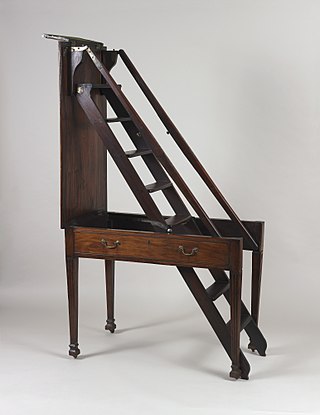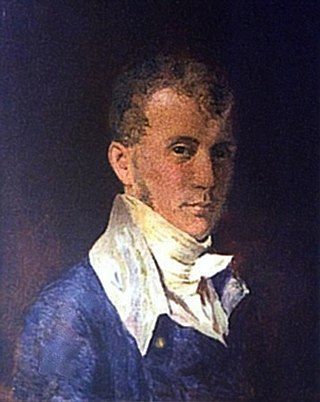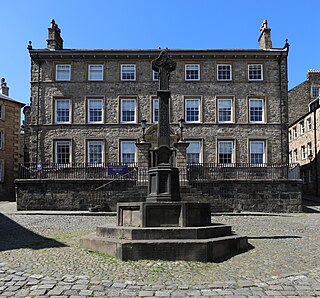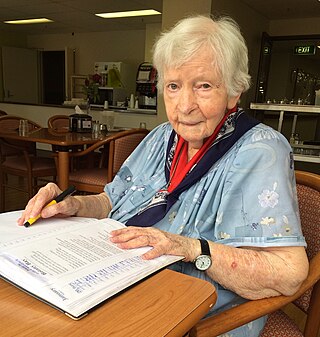
Furniture refers to objects intended to support various human activities such as seating, eating (tables), storing items, working, and sleeping. Furniture is also used to hold objects at a convenient height for work, or to store things. Furniture can be a product of design and can be considered a form of decorative art. In addition to furniture's functional role, it can serve a symbolic or religious purpose. It can be made from a vast multitude of materials, including metal, plastic, and wood. Furniture can be made using a variety of woodworking joints which often reflects the local culture.

Christie's is a British auction house founded in 1766 by James Christie. Its main premises are on King Street, St James's in London, and it has additional salerooms in New York, Paris, Hong Kong, Milan, Amsterdam, Geneva, Shanghai, and Dubai. It is owned by Groupe Artémis, the holding company of François Pinault. In 2022 Christie's sold US$8.4 billion in art and luxury goods, an all-time high for any auction house. On 15 November 2017, the Salvator Mundi was sold at Christie's in New York for $450 million to Saudi Prince Badr bin Abdullah Al Saud, the highest price ever paid for a painting.

A desk or bureau is a piece of furniture with a flat table-style work surface used in a school, office, home or the like for academic, professional or domestic activities such as reading, writing, or using equipment such as a computer. Desks often have one or more drawers, compartments, or pigeonholes to store items such as office supplies and papers. Desks are usually made of wood or metal, although materials such as glass are sometimes seen.

An antique is an item perceived as having value because of its aesthetic or historical significance, and often defined as at least 100 years old, although the term is often used loosely to describe any object that is old. An antique is usually an item that is collected or desirable because of its age, beauty, rarity, condition, utility, personal emotional connection, and/or other unique features. It is an object that represents a previous era or time period in human history. Vintage and collectible are used to describe items that are old, but do not meet the 100-year criterion.

Metamorphic library steps are a type of archaic dual-use furniture, consisting of a small folding staircase that can be transformed into chair or desk form. In desk form, it can also be considered a mechanical desk.

Duncan Phyfe was one of nineteenth-century America's leading cabinetmakers.

A bedroom or bedchamber is a room situated within a residential or accommodation unit characterized by its usage for sleeping. A typical western bedroom contains as bedroom furniture one or two beds, a clothes closet, and bedside table and dressing table, both of which usually contain drawers. Except in bungalows, ranch style homes, ground floor apartments, or one-storey motels, bedrooms are usually on one of the floors of a dwelling that is above ground level. Beds range from a crib for an infant; a single or twin bed for a toddler, child, teenager or single adult; to bigger sizes like a full, double, queen, king or California king). Beds and bedrooms are often devised to create barriers to insects and vermin, especially mosquitoes, and to dampen or contain light or noise to aid sleep and privacy.

A piece of antique furniture is a collectible interior furnishing of considerable age. Often the age, rarity, condition, utility, or other unique features make a piece of furniture desirable as a collectors' item, and thus termed an antique. The antique furniture pieces reflect the style and features of the time they were made; this can be called the antique's "period". Christie's defines it as being over 100 years old.

Ready-to-assemble furniture (RTA), also known as knock-down furniture (KD), flat-pack furniture, or kit furniture, is a form of furniture that requires customer assembly. The separate components are packed for sale in cartons which also contain assembly instructions and sometimes hardware. The furniture is generally simple to assemble with basic tools such as hex keys, which are also sometimes included. Ready-to-assemble furniture is popular with consumers who wish to save money by assembling the product themselves.
Campaign furniture is a type of furniture which is made for travel. Historically, much of it was made for military campaigns.
SteelcaseInc. is an international manufacturer of furniture, casegoods, seating, and storage and partitioning systems for offices, hospitals, classrooms, and residential interiors. It is headquartered in Grand Rapids, Michigan, United States.

Ashgrove is a suburb in the City of Brisbane, Queensland, Australia. In the 2021 census, Ashgrove had a population of 13,450 people.

The Judges' Lodgings, formerly a town house and now a museum, is located between Church Street and Castle Hill, Lancaster, Lancashire, England. It is recorded in the National Heritage List for England as a designated Grade I listed building. The building is the oldest existing town house in Lancaster, and was also the first house in Lancaster to have shutters. It was used by judges when they attended the sessions of the Assize Court.

Hamptons is an estate agent that has a UK network of more than 93 branches and an international affiliate partner network of over 7,000 offices. Hamptons' parent company, Countrywide, was acquired by The Connells Group in April 2021.

The desk in the Vice President's Ceremonial Office in the Eisenhower Executive Office Building, colloquially known as the Theodore Roosevelt desk, is a large mahogany pedestal desk in the collection of the White House. It is the first of six desks that have been used by U.S. presidents in the Oval Office, and since 1961 has been used as the desk of the U.S. Vice President.

Meta Truscott was an Australian diarist and Ashgrove historian. For over 80 years, she wrote a daily diary and collected scrapbooks, with pasted-in newspaper clippings and other ephemera (1934–2014). The diaries record the day-to-day life of a woman who had lived in Queensland all her life. The collection is in the Fryer Library, University of Queensland.
Profiles in History was an auction house in Los Angeles, California. It was founded in 1985 by Joseph Maddalena, who is an auctioneer and dealer of authentic and original collectibles, including Hollywood memorabilia, historical autographs, letters, documents, vintage signed autographs, and manuscripts. Maddalena was the company's president and CEO. It became defunct in January 2021 when Maddalena joined former rival Heritage Auctions.
Maple & Co. was a British furniture and upholstery manufacturer established in 1841 which found particular success during the Victorian and Edwardian eras. The company became one of the prime makers and suppliers of furniture to the aristocracy and royalty in both the United Kingdom and around the world.

Leonard Douglas Fryer was a British artist and designer. The son of a steel engraver, he worked for the printers Waterlow and Sons, preparing proposed designs for material to be produced by the firm such as stamps and banknotes. In 2019, a collection of his watercolour paintings for stamp and banknote designs was sold at auction after being found in a wardrobe 40 years after his death.

Ashgrove Uniting Church was a heritage-listed former church at 24–30 Ashgrove Avenue, Ashgrove, City of Brisbane, Queensland, Australia. Established in 1962 as the Ashgrove Methodist Church, the church is also known as The Grove Uniting Church. It was designed by James Gibson of Cross and Bain. It was added to the Queensland Heritage Register on 25 June 2021.




















